Things are good here. We're having some beautiful weather this past week, paired
with a really nice weekend. We went to a BBQ at Colm and Ann's on Saturday.
Mark and Moira were there. Colm's sister and brother-in-law were in visiting, as well.
I look so forward to seeing them when we all get together. It absolutely makes my
month! Before heading over there, we took an amazing nap and went grocery
shopping. Sunday we just hung out, (I nursed my hangover from drinking too much
wine). So, it was a quiet weekend, but after being out of town three weekends in
a row, it was just what the doctor ordered.
This will be a short week; We're leaving for Michigan on Thursday. I have vowed
to pack on Wednesday so I'm an organized traveler!! Hopefully between now and
then, I can get all the posts from Art and Mary's visit finished. We were busy bees.
So, I have a few more to do...
The next stop on our 'tour' was to Waterford. It took just over two hours to get there
from Kinsale. We stayed at the Faithlegg Hotel...Very nice place. Although, it was
hot and muggy that weekend. With no air conditioning, we were a little warm, but
we got a fan for the second night and that made all the difference!
The guys golfed both days at Faithlegg. The first day they were out smackin' 'em
around, Mary and I took a long walk and went out for dinner. Finding food proved
to be a challenge because most places stop serving between eight and nine in
the evening. After a few strikeouts, we finally found a place with an open kitchen.
But it was odd...When we asked if they were still serving food and the girl said,
"you can take a seat, but the kitchen is busy. So, we won't be able to take your
order for about fifteen minutes." I'd never heard that before! But we were happy to
know we could get food sometime in the near future.
Then, when the guy came by to take our order, I told him we wanted to get two
meals to go (for the guys). He said, "Our food comes on plates. We don't have
anything to put food in that you can leave with." Wwhaaat? I took a moment to
try to figure out if that's really what he said, and then after a mental deep breath,
suggested maybe they could put it in tin foil. He didn't bite on that at all.
Apparently, the concept of take away was not an idea he could wrap his mind
around! There was a small grocery market in the plaza we were in. So, Mary
went next door to buy her own tinfoil. We were determined to leave with food!
But then we found another server whose entire brain was in tact and was happy
to help us. So, we ate, got the two sandwiches to go for the guys...And after
all that...they ordered room service when they got done golfing!
The next day, we ventured off to Waterford Crystal during their golfing time. I find
a lot of their stuff far too ornate for my taste, but they do have some pieces that
are simple and really pretty. So, I got a couple of treats while we were there!
We already have two red wine glasses in the Clannad pattern that we got as a
gift from Shawn and Stephanie in 2003. They had them engraved with our names
and the year. This time, I got two white wine glasses in the same pattern. They're
engraved with 'The Links Ireland 2006'. I also got us two special rocks glasses.
Those are in the Lume pattern. They're really sharp. Nice and heavy. And then,
there's a part of the gift store that sells other things besides crystal. That's where
I found the ornaments. I had to get a few...They're so pretty! I couldn't resist!
The shopping was exciting, but even better was the tour of the factory.
We learned so much, and they encouraged photography! So, I can take you
along on the tour, too. I took a lot of pictures. So, grab a chair.
The tour started with a audio visual piece where we learned Waterford made The
Times Square Millennium Ball. (I took some photos, but the reproduction looked
a little silly against the fake NYC backdrop. So, I promptly deleted them.)
The ball was the largest and most expensive project in the history of Waterford
Crystal. It's made up of 504 triangular pieces of crystal which feature the ‘Star
of Hope’ design. It's seven points represent the seven continents of the earth.
The cross over points in the centre represents Mother Earth. It also contains
600 mulitcolored light bulbs and 96 strobe lights. It's six feet in diameter and
weighs 1,070 pounds and was completed with the work of 40 craftsman and
technical engineers.
Beware: These fun facts may cause drowsiness if shared with your friends
at your next New Years Eve party, especially when mixed with alcohol!
Waterford has sculptors that make specially commissioned pieces out of solid
blocks of crystal. We didn't get to witness those being made, but we did
get to see what they started with...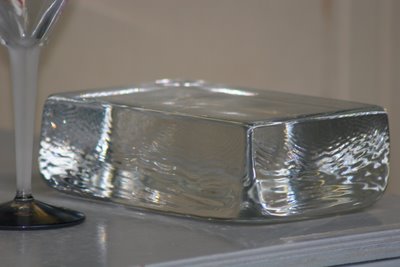
What separates crystal from glass is what's inside. Regular glass is made
of sand (silica), soda ash (sodium carbonate), and limestone (calcium carbonate).
When you combine those three ingredients and melt them together in a furnace
up to 1600 degrees centigrade, you'll get glass. The inclusion of lead is what
gives you crystal. The lead adds weight and allows for that light reflecting quality
you get with crystal. The lead oxide also makes the product softer and therefore,
easier to cut. I read that 24% lead oxide is the optimum amount for achieving the
best quality, and it's actually the minimum required amount for it to be considered
lead crystal. I'm not sure what percentage Waterford uses exactly, but it must be
at least 24%.
According to their website, "the ‘secret’ formula for Waterford Crystal is a special
mix of Litharge, Silica Sand and Potash. Smaller quantities of other chemicals
make up the unique formula, which gives our crystal its very special sparkle
and the remarkable weight of the finished product."
Most of you probably recognize this. It's Waterford's logo.
We learned a couple things about it that you might not know...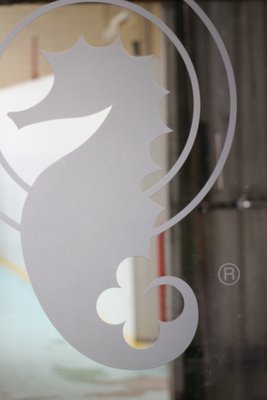
The reason this crystal company was able to set up
shop in Waterford in 1783 is because they were on the water.
The port gave them access to receive the three ingredients
they needed to make their product. This seahorse as their
logo is a tribute to the water and the port. If Waterford did
not have that harbor, Waterford Crystal could have just as
easily been called Dublin crystal or Howth crystal.
Also, to give some reference to Ireland in their company's
signature logo, the scallops of the seahorse's back curve into
the shape of a shamrock with the swoop of it's tail.
Finally, each piece of Waterford Crystal is marked on the bottom
with their logo. But they change it slightly every twenty years,
which helps to date the product. It was green and gold for some
time. They've used silver and navy. Other pieces have a frosted
logo just like the one in the picture above. That way, you can
identify the time period it was created. None of the Waterford lines
ever go out of production. So, one day when you inherit your
grandmother's Waterford Crystal, you can go back and order the
large bowl and complete the set. Or you can start collecting a set
when you're 20 and still add onto it when you're 60.
You very quickly form an appreciation for the value of Waterford Crystal once you
go on this tour. The process is pretty amazing, actually. And even more so is the
amount of training their craftsmen go through. This is serious stuff! Glass blowers
go through a five year apprenticeship. It takes years longer (usually around five)
on the job to reach Master Blower status. I believe they said cutters train in
apprenticeships for eight years. The engravers train for as long as 10 years!
After that kind of training, they're expected to produce perfect pieces...And those
are the only pieces they get paid for. They are not, in fact, paid a salary. Instead,
they get paid per flawless and salable piece. If there's an airbubble in it or the
shape is a little off, they get zero compensation for their time spent on it.
The following few pictures take you through the step-by-step process the glass
blowers go through in making one piece. Welcome to the Blowing Room.
After pulling the molten crystal out of the furnace...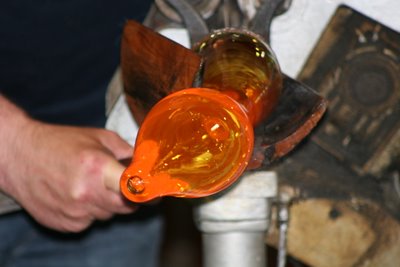
They start to shape it so it will later fit properly into the mold.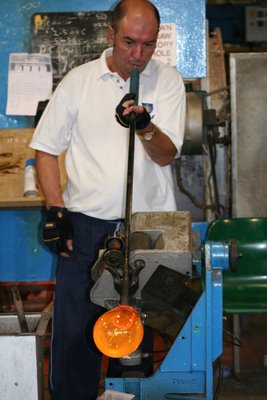
They blow air through the pole attatched to the piece and they
continue to shape it. They do all this pretty quickly so it stays hot.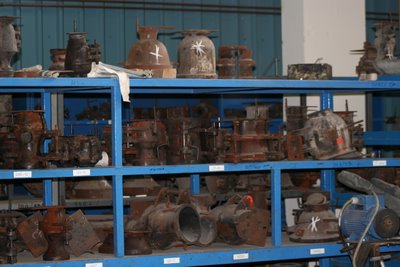
Next, they drop it into a mold. Waterford makes all their own
molds, usally with Beech and Pear Wood. This particular
group of molds is here for display.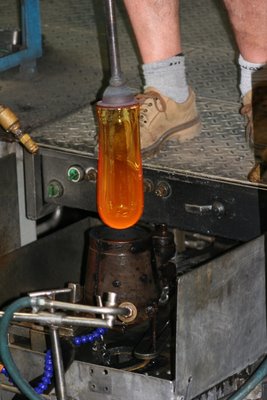
They drop it into the mold. Once there, they blow into the pipe
and spin the crystal until it takes the mold's shape.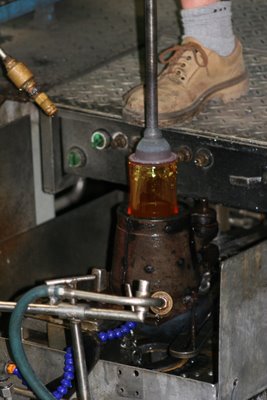
The crystal gets so hot in the furnace...1300 degrees Celsius is 2372
degrees Fahrenheit! No wonder it falls into shape so quickly.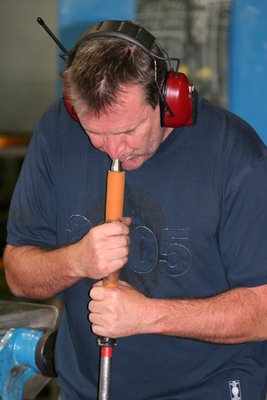
A little more air and spinning...
And there you have it. They make it looks so easy.
I guess that's their years of practice talking. 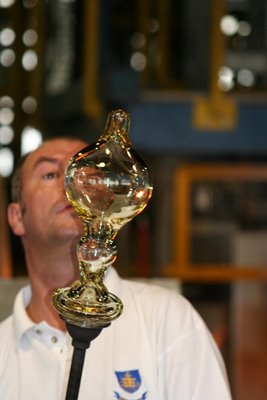
From there, it's pulled out and inspected.
One of the first of many inspections.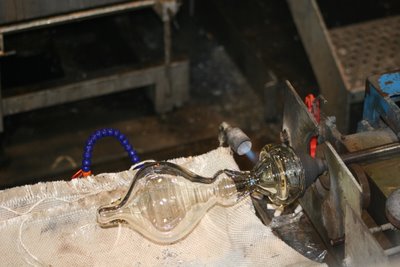
And then they place it on this canvas lined conveyor belt to be taken off
to it's next step.
Here's two other pieces they were working on when we first walked up...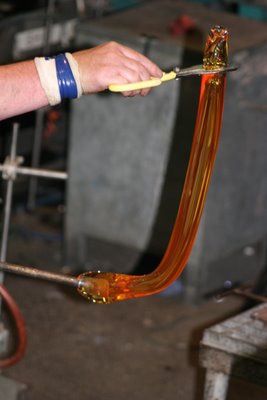
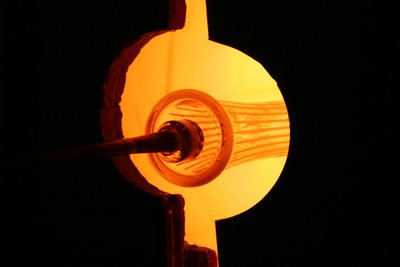
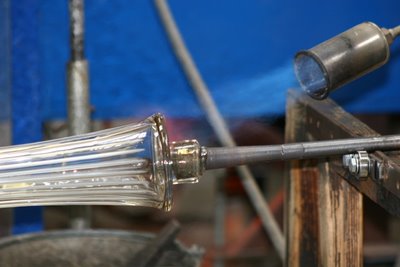
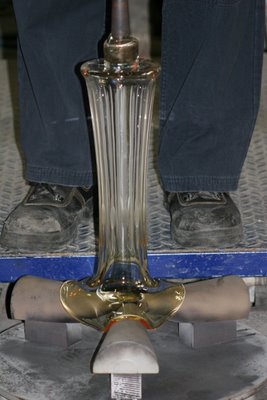
Next, we moved into the workshop.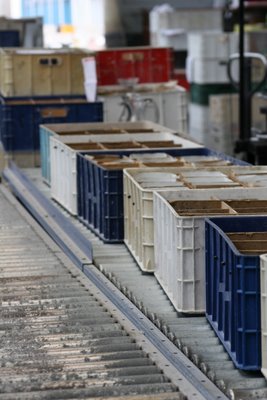
Each piece is marked with guides. The black lines are not actually used
to tell them anything about the pattern and where to cut it, but they serve
as guides for spacing. Everything else is done by sight, feel and memory.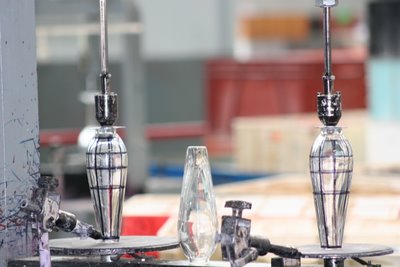
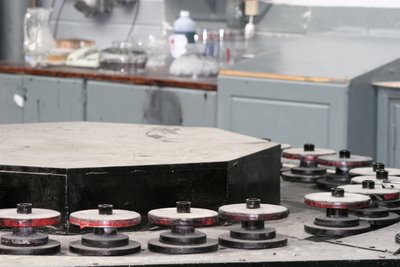
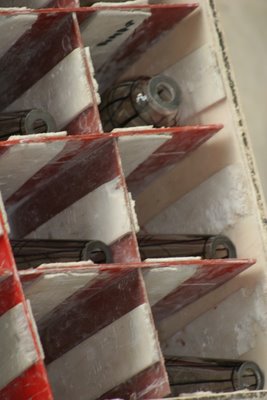
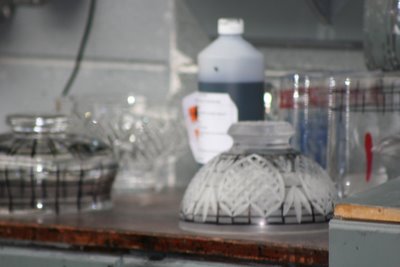
Two pieces side by side. One marked, the other marked and then cut.
After a piece is cut, it's rinsed in a special wash. I think they said it was
an acid wash.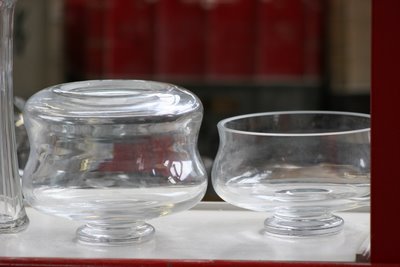
Before and after. They blow the whole piece and then cut the top off to make a bowl.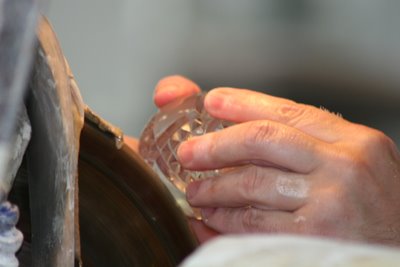
The master cutters then get to work. I am still amazed that they eyeball cuts.
A piece has to be precise to be considered salable. Each cut must have a
very specific depth, with any cuts that aren't deep enough or are too deep
rendering it useless for sale. The same with the height of a cut. If it's a millimeter
too high or a millimeter to low, the piece is scrapped and recycled whenever possible.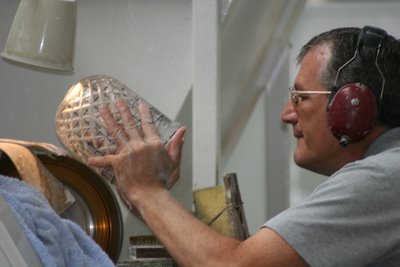
Like the glass blowers, master cutters are only paid per salable piece.
So, if they cut an entire bowl or vase flawlessly and then the last cut
is just a tiny bit too deep, it's worth nothing. They must pay meticulous
attention and come to work with a steady hand!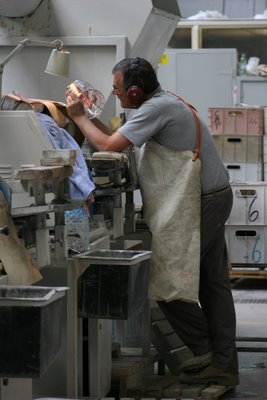

Their tool is a diamond-tipped wheel. It has a small flow
of water that constantly flows as the wheel rotates.
If it were dry, too much friction would be created which would
heat the glass and make it impossible for the cutter to hold onto.
I've already mentioned the training involved in becoming a master craftsperson
with Waterford. Today, people start their apprenticeships at the age of
18 or 19 years old after graduating from high school. But a generation ago,
they began when they were 15 or 16 years of age. Very few woman signed
on for such an apprenticeship, but it wasn't because they weren't interested or
that the work was too hard. Instead, it was due to a legal restriction. The law
in Ireland at that time stated woman could hold jobs in a factory, but once they
became married and/or pregnant, they had to leave. No choice in the matter.
The reality was that around the time most people would be finishing the program,
they would be at that point in their lives where they might be thinking of getting
married and starting a family. So, it didn't make sense to woman to dedicate so
many years of training on a career they would not be allowed to continue working in.
That law has now been amended, but it changed rather recently. There is only one
female master craftsperson employed with Waterford, and I think they said she is
the only one ever employed by them. They've appropriately hung her photograph in
the hallway with some of their more special trophy pieces. She's a bit of a hero
to them. As she should be! 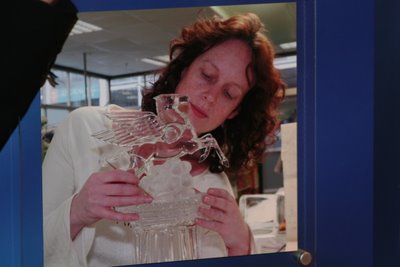
It's just amazing to me to think that such a short time ago, women were put
in such a position. It's not like Ireland was that far off from other parts of the
world. Why women in the United States have only been allowed to vote for
86 years. (Thank god for the 19th amendment of the Constitution!) 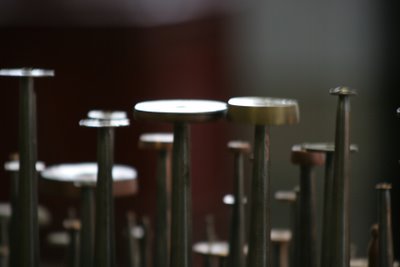
And now comes the hard part. These are the tools used by the master
engravers when doing the more intricate work of special pieces and trophies.
As some of this work can take up to six months on one piece, these people
earn a regular salary as opposed to getting paid per salable piece like
the glass blowers and cutters.
Those 'special pieces' are often trophies made for professional sports prizes.
They said they always make "a just in case piece". In other words, they make
an entire and exact duplicate in case the original trophy breaks in transit. Probably
not a bad idea! Waterford is making the trophy for the upcoming Ryder Cup winners.
There was a two person team at Waterford the day of our tour. One holding a
camera, the other a microphone. They were making a piece that will air just before
the trophy is awarded.
This is another example of a piece the master engravers would make...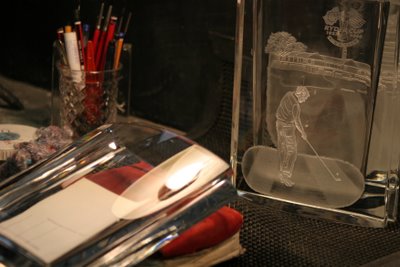
Mary pointed out that this person is using a crystal cup as a pen holder!
I hadn't even noticed that, but that is a hell of a lot nicer than the $2 mug
we use at home. I thought it was neat to see the before and after of this piece.
I guess the artist who is making the new one uses the image from the other as
his guide. That's amazing talent right there! And you can take one of these
Ryder Cup pieces home for a mere 785 euros. That's $992.32!! Ah, come on.
That's pocket change!

No comments:
Post a Comment